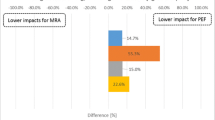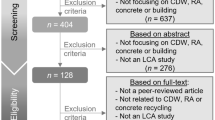Abstract
Purpose and scope
Two ISO-compliant approaches on modelling the recycling of plastics and metals are frequently applied in life cycle assessment case studies and intensively debated: the recycled content or cutoff approach and the end of life recycling or avoided burden approach. This paper discusses the two approaches from three different perspectives: (1) the kind of sustainability concept served, (2) the risk perception involved and (3) the eco-efficiency indicators resulting from the two approaches.
Results and discussion
The analysis shows that the recycled content approach serves the strong sustainability concept. It is based on a risk-averse attitude and results in higher eco-efficiency of metal scrap recycling as compared to primary metal manufacture. The end of life recycling approach serves the weak sustainability concept (losses in natural capital can be compensated by man-made capital). It corresponds to a risk-seeking attitude and results in higher eco-efficiency of primary metal manufacture as compared to secondary metal production.
Conclusions
It is concluded that a harmonisation of the approaches is hardly possible due to the value choices involved. It is the task of (private and public) life cycle assessment commissioners to decide on the appropriate modelling approach. National authorities may have a rather long-term and risk-averse perspective, whilst industries may prefer a short-term perspective leading them to select the recycled content and end of life recycling approach, respectively. Life cycle inventory databases need to be flexible to serve such opposing perspectives and to enable practitioners to adapt the modelling approaches according to the needs of the commissioner.

Similar content being viewed by others
Notes
Seven million tons relative to 34.4 million tons in 2003 and 13 million tons relative to 51 million tons in 2020.
Future generations may argue with the sunk cost argument that the emissions to manufacture primary aluminium happened in the past and can no more be influenced. Hence, there is no reason to take past emissions into considerations in their decisions.
References
Anonymous (2006) Declaration by the metals industry on recycling principles. Int J Life Cycle Assess 12:59–60
Curran M-A (2006) Co-product and input allocation approaches for creating life cycle inventory data: a literature review. Int J Life Cycle Assess 12:65–78
Curran MA (2008) Development of life cycle assessment methodology: a focus on co-product allocation. Erasmus University Rotterdam, Rotterdam
EAA (2000) Environmental profile report for the European aluminium industry, April 2000. European Aluminium Association, Brussels
ecoinvent Centre (2006) ecoinvent data v1.3. Final ecoinvent reports no. 1-16. Swiss Centre for Life Cycle Inventories, Duebendorf. ISBN 3-905594-38-2
Ekvall T, Tillmann A-M (1997) Open-loop recycling: criteria for allocation procedures. Int J Life Cycle Assess 2:155–162
Ekvall T, Weidema B (2004) System boundaries and input data in consequential life cycle inventory analysis. Int J Life Cycle Assess 9:161–171
Frischknecht R (1994): Allocation—an issue of valuation? In: Huppes G, Schneider F (eds) European Workshop on Allocation in LCA. Society of Environmental Toxicology and Chemistry, SETAC, 24–25 February 1994, Leiden, The Netherlands, pp 122–131
Frischknecht R (2000) Allocation in life cycle inventory analysis for joint production. Int J Life Cycle Assess 5:85–95
Frischknecht R (2006) Notions on the design and use of an ideal regional or global LCA database. Int J Life Cycle Assess 11:40–48
Guinée JB, Heijungs R, Huppes G (2004) Economic allocation: examples and derived decision tree. Int J LCA 9:23–33
Heijungs R, Frischknecht R (1998) On the nature of the allocation problem. Int J Life Cycle Assess 3:321–332
Hertwich E, Hammitt JK, Pease WS (2000) A theoretical foundation for life-cycle assessment: recognizing the role of values in environmental decision making. J Ind Ecol 4:13–28
Hofstetter P, Baumgartner W, Scholz R (2000) Modelling the valuesphere and the ecosphere: integrating the decision makers’ perspectives into LCA. Int J LCA 5:161–175
ISO (International Organization for Standardization) (2006a) Environmental management—Life cycle assessment—Principles and framework. ISO 14040:2006; Second Edition 2006-06, Geneva
International Organization for Standardization (ISO) (2006b) Environmental management—Life cycle assessment—Requirements and guidelines. ISO 14044:2006; First edition 2006-07-01, Geneva
Kicherer A, Schaltegger S, Tschochohei H, Ferreira Pozo B (2007) Eco-efficiency. Combining life cycle assessment and life cycle costing via normalization. Int J Life Cycle Assess 12:537–543
Kim S, Hwang T, Lee K-M (1997) Allocation for cascade recycling system. Int J LCA 4:217–222
Klöpffer W (1996) Allocation rule for open-loop recycling in life cycle assessment—a review. Int J Life Cycle Assess 1:27–31
Martchek K (2006) Modelling more sustainable aluminium. Int J Life Cycle Assess 11:34–37
Neumayer E (2003) Weak versus strong sustainability: exploring the limits of two opposing paradigms. Edward Elgar, Cheltenham
SETAC (1993): Guidelines for life-cycle assessment: a “Code of Practice”. SETAC Workshop. Society of Environmental Toxicology and Chemistry (SETAC), Brussels, Belgium and Pensacola (Florida, USA). Sesimbra, Portugal, 31 March–3 April 1993
Weidema B (2001) Avoiding co-product allocation in life-cycle assessment. J Ind Ecol 4:11–33
Werner F (2002) Interdependencies between LC-modelling and the use of LCA in product design-related decision situations. PhD thesis, ETHZ, Zürich
Werner F, Richter K (2000) Economic allocation in LCA: a case study about aluminium window frames. Int J LCA 5:79–83
Yamada H, Daigo I, Matsuno Y, Adachi Y, Kondo Y (2006) Application of Markov chain model to calculate the average number of times of use of a material in society. An allocation methodology for open-loop recycling. Part 1: methodology development. Int J Life Cycle Assess 11:354–360
Author information
Authors and Affiliations
Corresponding author
Additional information
Responsible editor: Hans-Jürgen Garvens
Rights and permissions
About this article
Cite this article
Frischknecht, R. LCI modelling approaches applied on recycling of materials in view of environmental sustainability, risk perception and eco-efficiency. Int J Life Cycle Assess 15, 666–671 (2010). https://doi.org/10.1007/s11367-010-0201-6
Received:
Accepted:
Published:
Issue Date:
DOI: https://doi.org/10.1007/s11367-010-0201-6




